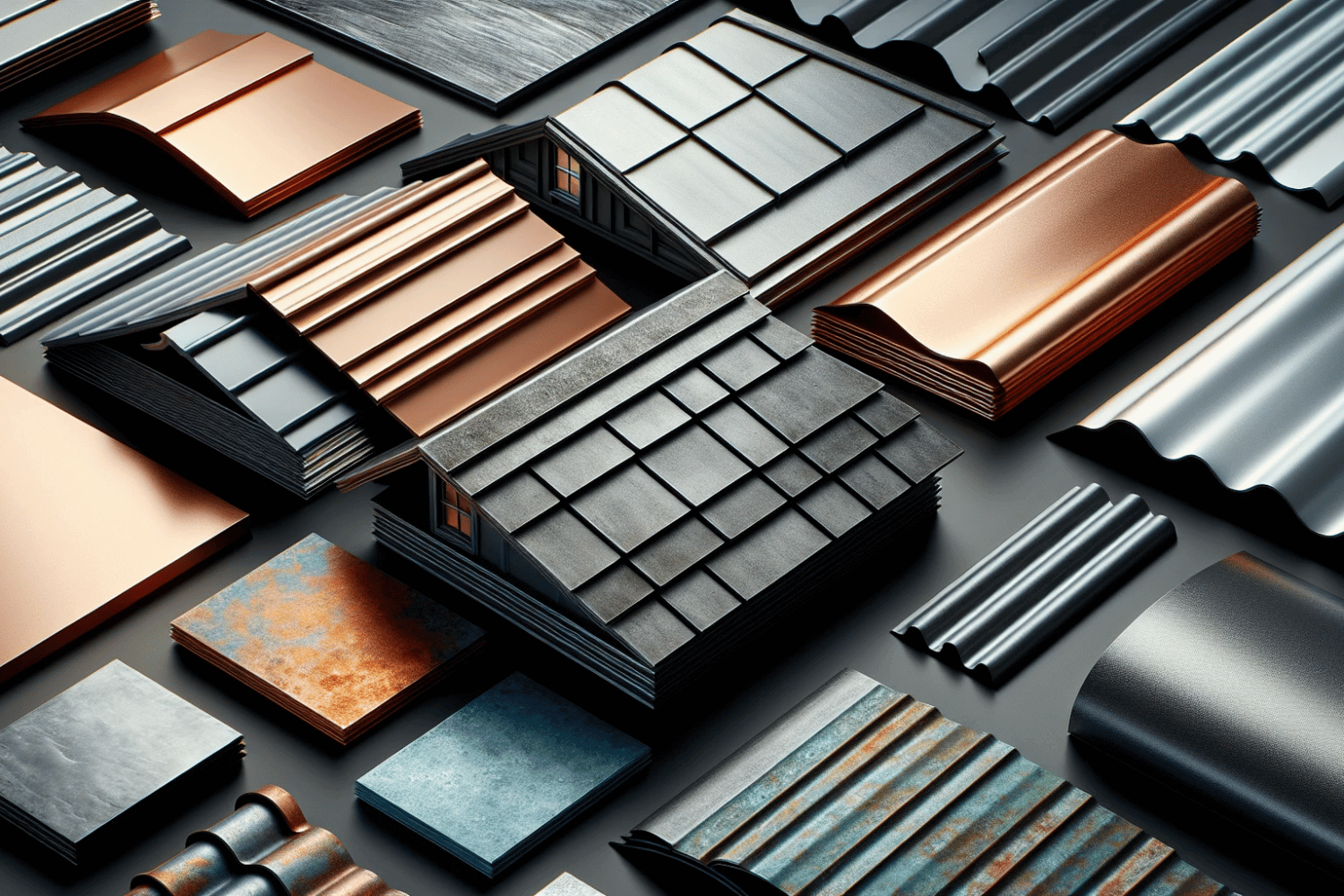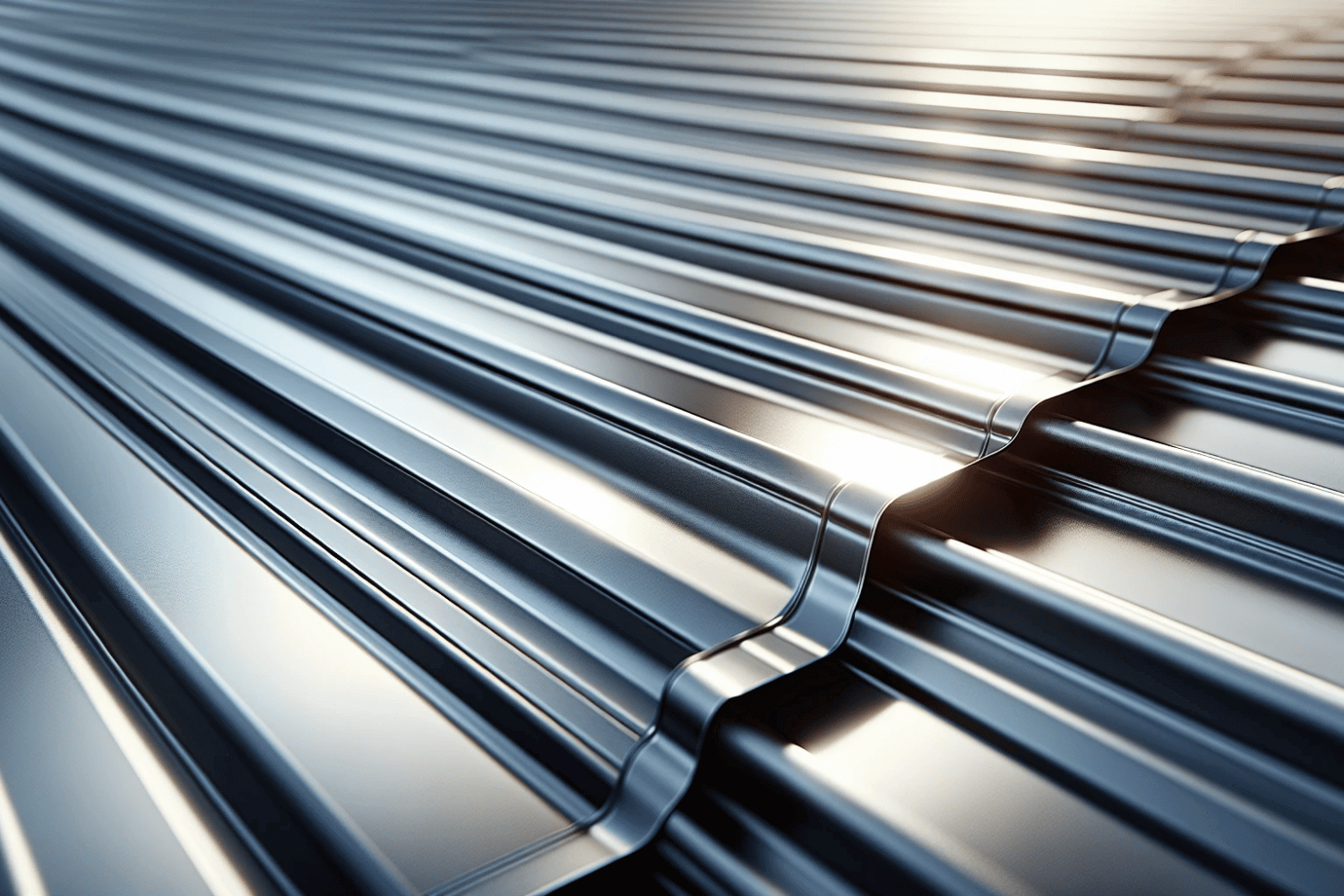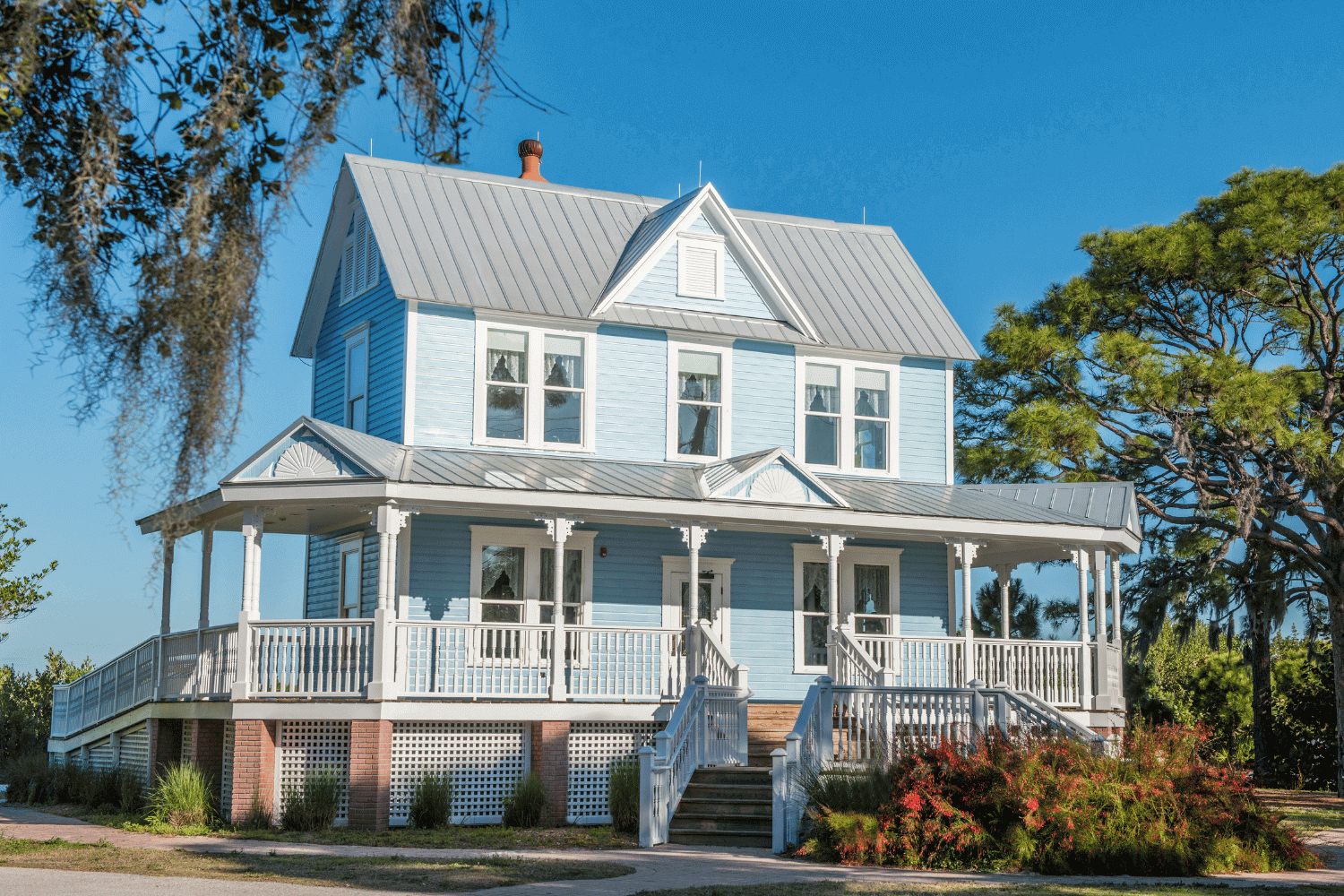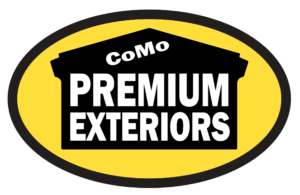Are you considering a new roof for your home? Metal roofing, specifically a metal roof, has become increasingly popular, offering numerous benefits that surpass traditional roofing materials. Discover the advantages of metal roofs, their different types, and how to make the best choice for your home in this comprehensive guide.
Key Takeaways
- Metal roofing is an attractive choice for homeowners due to its long lifespan, energy-efficiency, reflection of heat, fire-resistance and minimal maintenance requirements.
- Different metal roofing materials offer various advantages in terms of cost, climate/weather resistance and aesthetics.
- Proper installation by a qualified contractor as well as regular maintenance are essential for maximizing the performance and longevity of your metal roof.
Understanding Metal Roofing: A Comprehensive Guide

Illustration of various metal roofing materials
Metal roofing is a durable and versatile option, perfect for homeowners seeking a long-lasting and energy-efficient solution for their homes. With an expected lifespan of 50 years or more, metal roofs easily outlast traditional roofing materials like asphalt shingles. They are also resistant to extreme weather conditions, offering protection against wind, rain, snow, and even fire.
Aluminum, copper, steel, and zinc are among the various metal roofing materials available. Each material possesses unique properties and advantages. Understanding the differences between them aids in selecting the most suitable one for your specific needs and climate.
This guide will cover the following topics:
- The benefits of metal roofing
- Popular metal roofing materials
- Different panel types and profiles
- Factors to consider when choosing a metal roof
Let’s get started!
Benefits of Metal Roofing
Metal roofing offers numerous benefits that make it an attractive choice for homeowners. One of the most significant advantages is its durability, with metal roofs known to last up to 50 or 60 years, outlasting traditional roofing materials like asphalt shingles. This long lifespan means less frequent roof replacements and a lower lifetime cost.
In addition to its durability, metal roofing offers several benefits:
- Highly energy-efficient, reducing cooling costs by 10-25%
- Reflective nature minimizes the absorption of heat, keeping your home cooler during hot summer months
- Fire-resistant
- Requires minimal maintenance
These advantages make metal roofs a practical and cost-effective choice for many homeowners.
Popular Metal Roofing Materials
When it comes to metal roofing materials, there are several options to choose from, each offering its unique set of properties and benefits. Aluminum is known for its corrosion and saltwater damage resistance, making it suitable for coastal homes. Copper is robust, lightweight, and aesthetically pleasing, offering a distinctive look for those seeking a unique roofing option.
Steel is another popular choice, offering strength and resilience. Galvanized steel, for example, provides excellent protection against rust and corrosion. Zinc, on the other hand, can form an appealing patina that safeguards the metal from further corrosion. Understanding the characteristics of each material aids in selecting the best option based on your home’s unique needs and environment.
Metal Roof Panels: Types and Profiles

Photo of exposed fastener panels on a metal roof
In addition to the various materials, metal roofs are available in different panel types and profiles, including metal panels. Each type offers specific advantages and aesthetic appeal, making it essential to choose the right one for your home and personal preferences. This section will cover exposed fastener panels, standing seam systems, and metal shingles and tiles, providing an overview of each option and its unique characteristics.
Understanding the different panel types and profiles aids in a more effective selection of a metal roof. It’s about finding a balance between performance, aesthetic appeal, and budget to maximize your investment.
Exposed Fastener Panels
Exposed fastener panels are an economical option for metal roofing. These panels feature overlapping metal sheets that are secured directly to the roof deck or framing via the face of the metal. This type of roofing system is also known as a screw-down panel system, as the fasteners are visible on the surface of the roof. In contrast, concealed fastener panels offer a different aesthetic, with hidden fasteners providing a cleaner appearance.
The advantages of utilizing exposed fastener panels for metal roofing include:
- Cost-efficiency
- Longevity
- Straightforward installation
- Distinctive design possibilities
These corrugated panels are also resistant to weather, pest, and fire damage. However, proper installation and maintenance are important, as this type of roofing system has limited flexibility during thermal cycling, which could be an issue for panel runs longer than 40 feet.
Standing Seam Systems

Illustration of standing seam metal roof panels
Standing seam systems are another popular choice for metal roofing, offering a sleek and modern appearance. These metal roofing systems feature standing seam roofs with:
- Wide, flat, and vertical panels with a rib at either end of the panel
- Hidden fasteners found beneath the ribs of the standing seam panels
- An interlocking roofing system, providing a streamlined look suitable for various architectural styles.
One of the key advantages of standing seam panels is that they do not have any exposed fasteners, making them impervious to weathering and other external stresses that may cause degradation over time. The ribs and locking mechanisms of standing seam panels provide flexibility and allow for temperature changes, making them a popular choice for both residential and commercial applications.
Metal Shingles and Tiles

Photo of residential building with metal shingles and tiles
For homeowners who prefer the look of traditional roofing materials but still want the advantages of metal roofing, metal shingles and tiles are an excellent option. These roofing materials resemble other roofing materials like asphalt shingles, wood shakes, or clay tiles, while offering the durability and performance of metal roofing.
Metal shingles and tiles come in various styles, including stone-coated steel roofing, metal shingles that resemble wood shakes, and metal tiles that mimic the appearance of clay or concrete tiles. By opting for metal shingles or tiles, you can enjoy the benefits of metal roofing without sacrificing the aesthetic appeal of traditional roofing materials.
Factors to Consider When Choosing a Metal Roof
When selecting a metal roof for your home, there are several factors to consider:
- Cost and budget
- Climate and weather resistance
- Aesthetics and style
- Installation requirements
By taking the time to evaluate these factors, you can make a more informed decision that will result in a high-quality roof that meets your specific needs.
In the following parts, we will discuss each of these factors in more detail to aid you in choosing the optimal solution for your metal roofing project.
Cost and Budget
One of the critical factors to consider when choosing a metal roof is the overall cost, including the cost of the roofing material itself, installation, and maintenance expenses. Metal roofing materials can vary in price, with options like:
- Steel
- Aluminum
- Copper
- Zinc
Steel and aluminum are typically more affordable options compared to copper or zinc, making zinc and aluminum alloys a popular choice for many industries.
Assessing your budget should also involve considering the long-term costs associated with your chosen roofing material. Although metal roofing may have a higher initial cost, its durability and low maintenance requirements could lead to significant savings over time. By taking into account both initial and ongoing costs, you can select a metal roofing option that aligns with your financial needs.
Climate and Weather Resistance
Another crucial factor to consider when selecting a metal roof is its ability to withstand your region’s climate and weather conditions. Metal roofing materials are generally well-suited for various climates, offering protection against extreme temperatures, high winds, and heavy precipitation.
For example, steel and aluminum roofing materials are ideal for hot climates, as they reflect sunlight and heat, helping to keep your home cooler during the summer months. In colder climates, metal roofs can provide excellent insulation and durability, ensuring your home stays warm and protected throughout the winter. By choosing a metal roofing material that is suitable for your local climate, you can ensure a long-lasting and high-performing roof.
Aesthetics and Style
The aesthetics and style of your metal roof are crucial considerations, as they can significantly impact your home’s overall appearance and curb appeal. Metal roofing materials come in various styles and designs, including:
- Standing seam
- Metal shingles
- Metal tiles
- Corrugated metal
These options allow you to select a roof that complements your home’s architecture.
From standing seam panels that offer a sleek, modern look to metal shingles and tiles that mimic traditional roofing materials, there are plenty of options to choose from. When selecting a metal roof, consider your home’s architectural style and personal preferences, ensuring a cohesive and visually appealing result.
Installation Requirements
Understanding the installation requirements for your chosen metal roofing material is essential to ensure a successful installation. Each type of metal roofing material may have specific requirements, including necessary tools, equipment, and expertise.
It is crucial to hire a qualified and experienced metal roofing contractor to install your metal roof correctly. They should be familiar with the specific installation requirements for your chosen material and have the necessary tools and equipment to complete the job efficiently and effectively. By ensuring proper installation, you can maximize the performance and longevity of your metal roof.
Comparing Metal Roofs to Other Roofing Materials
When considering a metal roof, it can be helpful to compare its advantages and disadvantages to other roofing materials. While metal roofs offer numerous benefits, such as durability, energy efficiency, and fire resistance, they may also have a higher upfront cost compared to traditional roofing materials like asphalt shingles.
However, the long-term benefits of metal roofing often outweigh the initial cost, as metal roofs typically require less maintenance and have a longer lifespan than other roofing materials. By evaluating the pros and cons of metal roofing in comparison to other options, you can make an informed decision about the best roofing choice for your home.
Hiring a Metal Roofing Contractor
Once you’ve chosen a metal roof, you should hire a reputable, experienced metal roofing contractor to guarantee a successful installation. Here are some tips for finding the right contractor:
- Look for a licensed, bonded, and insured contractor.
- Check for positive customer reviews or testimonials.
- Make sure they offer warranties for their work.
- Ask for a written contract detailing the scope of work, materials, and payment terms.
By following these steps, you can ensure that your metal roof installation is done by a qualified professional.
Additionally, consider any specific certifications a metal roofing contractor should possess, such as those offered by the National Roofing Contractors Association (NRCA). By hiring a qualified and experienced metal roofing contractor, you can ensure that your new metal roof is installed correctly and will provide years of protection and performance.
Solar Panels and Metal Roofs: A Perfect Pairing?
Solar panels and metal roofs can be an ideal pairing, combining the benefits of renewable energy and durable roofing. Metal roofs are compatible with solar panels, providing a secure and reliable foundation for the installation.
In addition to their compatibility, the combination of metal roofs and solar panels can offer several benefits:
- Reduce your home’s energy consumption
- Lower your utility bills
- Maximize your home’s energy efficiency
- Contribute to a more sustainable future
Caring for Your Metal Roof: Maintenance Tips

Illustration of maintenance tips for metal roofs
Regular maintenance and care are vital for the longevity and performance of your metal roof. Key maintenance steps include:
- Clearing gutters and drains
- Removing dirt and stains from the surface
- Trimming branches to avoid contact
- Conducting annual inspections
By following these maintenance tips, you can keep your metal roof looking its best and ensure it provides lasting protection and performance. With proper care, your metal roof can be an investment that serves your home for decades.
Summary
In conclusion, metal roofing offers numerous benefits, including durability, energy efficiency, and fire resistance. With various materials and styles to choose from, you can find a metal roof that complements your home’s architecture and enhances its curb appeal. By considering factors such as cost, climate, aesthetics, and installation requirements, you can make an informed decision and enjoy the lasting benefits of a metal roof for years to come.
Frequently Asked Questions
What is the biggest problem with metal roofs?
Metal roofing can present a range of issues such as poor installation, leakage, rust and corrosion, noise, thermal expansion and contraction, missing fasteners, poor insulation and energy efficiency, and denting, making it difficult to maintain and potentially costly to repair.
Is it cheaper to put a metal roof or shingles?
A metal roof will always be more expensive than shingles, as the metal panels and additional skill and labor required for installation cost more.
Is it worth it to put on a metal roof?
Investing in a metal roof may cost more up-front, but its durability and longevity make it worth it. You’ll likely save on future roof repairs, lower your electricity bills, and potentially increase your home’s resale value.
What are the 2 types of metal roofs?
Metal roofs come in two primary types: corrugated metal roofing with exposed fasteners and standing seam roofing with concealed fasteners. Metal shingle, slate, and tile roofing are also available as more decorative alternatives.
What is the average lifespan of a metal roof?
The average lifespan of a metal roof is over 50 years, depending on the material and system used.

